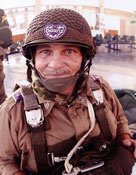 Vietnam vet to develop a therapy program to help veterans suffering from PTSD
Vietnam vet to develop a therapy program to help veterans suffering from PTSD
by Audrey Parente
DELAND — Dallas Wittgenfeld's life after Vietnam travels two paths — one exhilarating, the other somber.
He wisecracks about leaping out of airplanes, helicopters and hot-air balloons into mall parking lots, speedways and even the Cayman Islands — as Thunder Chicken or Sky Pirate.
"I wore out two hot-air balloons, and the first time Volusia County ever saw Thunder Chicken was flying Grand National Winston Cup champion Donnie Allison off a hotel roof," says Wittgenfeld of Orange City.
But the two-time Purple Heart Vietnam veteran Airborne Ranger nearly cries if you ask him about his military service.
About a June leap with the Liberty Jump Team over Normandy to re-create Word War II history, the former paratrooper says:
"In France, I was introduced as a Vietnam veteran. They already had a hole in their hearts from their history in Vietnam and respect Vietnam veterans. They bent their flags to me, and I thought, 'Wow, they never did that for me back home.' "…
The 58-year-old says the adrenaline rush from sky diving was a sort of catharsis for post-traumatic stress disorder, the aftermath of war for thousands of veterans then and now. The Department of Veterans Affairs reports PTSD affects nearly 18 percent of Iraq war veterans.
Now, Wittgenfeld is appealing to veterans organizations for funding and working with Dr. Ray Scurfield, former director of Veterans Affairs National PTSD Center in Honolulu, to develop a therapy program to help veterans suffering from the disorder.
For 20 years, Scurfield directed VA post-traumatic stress programs, including helicopter-ride therapy for traumatized Vietnam, Korea and World War II veterans.
"It's a very powerful trigger," Scurfield explains in a phone interview from the University of Southern Mississippi Gulf Coast School of Social Work, where he now is a professor.
"In the Iraq war, helicopters and Humvees are two things people most relate to the war. So to have some kind of a helicopter ride experience for U.S. Iraqi vets would be a powerful trigger to bring things they are avoiding to the surface."
Wittgenfeld says he didn't get that kind of help early enough.
"When I came home from Vietnam, I was 20 years old, on leave. I wore my uniform with my friends and went out drinking, but I couldn't vote or buy booze anywhere — and they made fun of me, so I got up and left," Wittgenfeld recalls.
"I was proud of what I had done, and when I came back, I thought I was a hero — but no one else did."
So he laid low and "didn't talk about the military," but instead became a thrill-seeking clown.
In 1993, after hearing news of "Black Hawk Down," an incident that began as a Somalian humanitarian mission but ended in fighting and death, Wittgenfeld says he "lost it."
A nurse friend said, " 'You have a problem,' so I went to the VA and told them."
Diagnosis: PTSD. He got help and says, "It was like pulling a raw scab off my heart."
Wittgenfeld continued sky diving but says, "After 9/11, everybody went into big red, white and blue spirit."
He switched to patriotic themes.
"I am an old, baldheaded, toothless guy now, but this is my country," he says. "Now, I go to the Military Order of the Purple Hearts, and they bring up PTSD. I am looking for a way to help. I am looking for a helicopter."
He hopes veterans groups will help fund an appropriate program.
Scurfield says a helicopter therapy program would need "a helicopter, maintenance and transporting and a mental-health support piece to it."
Dr. Thomas Hundersmarck, coordinator of the VA PTSD Clinic in Gainesville, says programs need secure therapeutic environments and careful screening to assess reactions.
"Most therapies involve exposing the past," Hundersmarck says. "(Veterans) can come to understand what it meant then, what it means now and, in a sense, detoxify very fearful, terrible moments they've gone through."
Scurfield supports Wittgenfeld's therapy program efforts.
"He has a contagion to him that is positive, and things get off the ground that way."
Did You Know?
Parachutes have changed shape over the centuries.
· The first-known written account of a parachute concept is found in Leonardo da Vinci's notebooks from about l495.
· Parachutes evolved from the 1700s through the early 1900s to the conventional round solid silk cloth used during the 1930s.
· The development of square and winged sport parachutes beyond solid to slotted cloth with cells came in the early 1960s.
· Modern square chutes are generally constructed of seven to nine cells.
· Round parachutes have always been considered sound and safe, but modern square parachutes have vastly superior maneuverability.
SOURCES: Compiled by Staff Writer Audrey Parente from American Institute of Aeronautics and Astronautics and parachutehistory.com
ATTENTION READERS
We See The World From All Sides and Want YOU To Be Fully InformedIn fact, intentional disinformation is a disgraceful scourge in media today. So to assuage any possible errant incorrect information posted herein, we strongly encourage you to seek corroboration from other non-VT sources before forming an educated opinion.
About VT - Policies & Disclosures - Comment Policy




